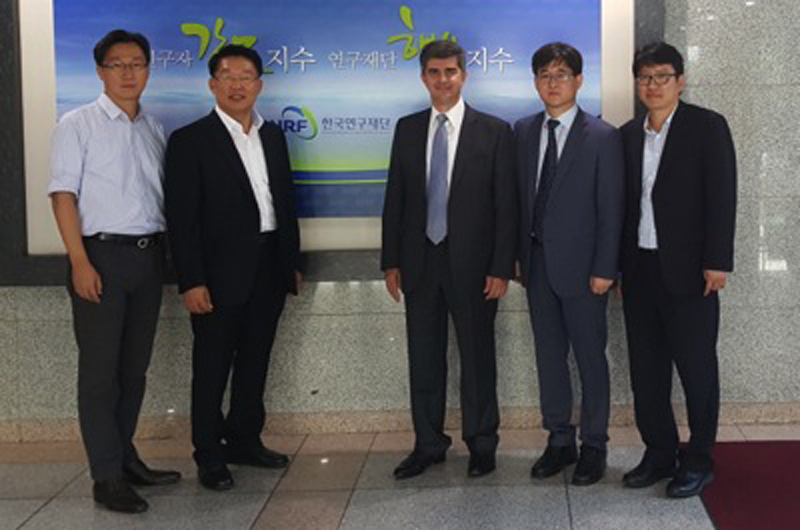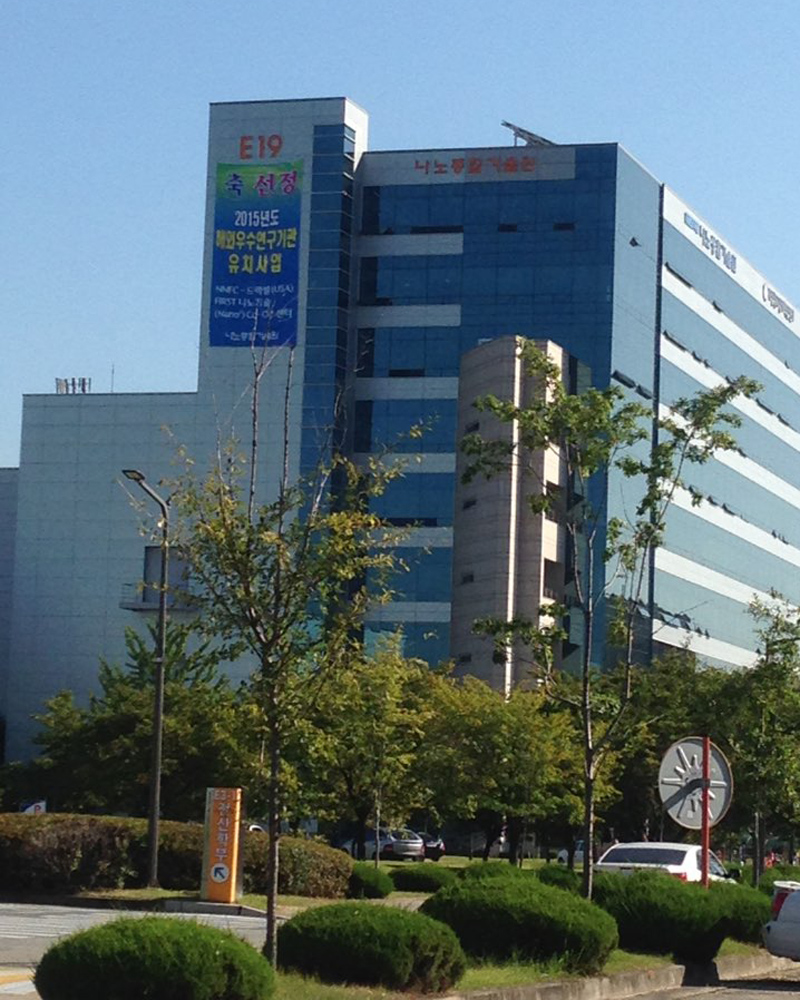
U.S.-Korea team of presenters at the Korean National Research Foundation. (L-R): MinJun Kim (Drexel); Jaeyoung Lee, NNFC President; Yury Gogotsi (Drexel); Chi Won Ahn (NNFC) and Hee-Tae Jung (KAIST).
Quality materials, reliable tools and talented artisans are the key ingredients of any successful workshop. When it comes to making electronics components and energy storage devices, discoveries emerge when new materials are used in advanced fabrication techniques. Students from Drexel University and the Korea Advanced Institute of Science and Technology will soon be in the presence of both. A co-op partnership with Korea’s National Research Foundation will give the students a chance to apply their talents in the nanofabrication center frequented by companies like Samsung and Hyundai, using the latest nanomaterials developed by Drexel’s materials scientists.
Starting in the spring term, students from Drexel will travel to Korea’s National NanoFab Center in Daejeon, South Korea for a three-to-six month co-operative learning experience in the center where many of the country’s leading electronics manufacturers come to refine their designs. The international partnership, dubbed FIRST Nano2 Co-op Center, is funded by a grant from Korea’s equivalent of the National Science Foundation.
“The creation of this international center for co-operative education not only aligns with the goals of our strategic plan to enhance Drexel’s global impact, but also strengthens our partnership with Korean counterparts to forge global partnerships that address the technological challenges of the 21st century,” said Drexel President John A. Fry, who will travel to Korea to celebrate the opening of the center this fall.
On the other side of the world, students from KAIST will experience co-op positions with researchers from the A.J. Drexel Nanomaterials Institute, the Drexel Biological Actuation Sensing & Transport Laboratory, and other research groups in Drexel’s College of Engineering. This will put them in contact with scientists who are developing next-generation energy storage materials like graphene and MXenes, as well as researchers who are figuring out how nanomaterials could be put to use in medicine and biology.
 The international co-op partnership was selected from a competitive pool of applicants for the NRF’s Global Research Development Center program. It will be funded by a $900,000 renewable, annual grant that will support up to 19 students from both institutions during the course of the year. And it draws on the foundation of Drexel’s well-established co-op program, which annually places hundreds of students in experiential educational opportunities with employers and research institutions abroad.
The international co-op partnership was selected from a competitive pool of applicants for the NRF’s Global Research Development Center program. It will be funded by a $900,000 renewable, annual grant that will support up to 19 students from both institutions during the course of the year. And it draws on the foundation of Drexel’s well-established co-op program, which annually places hundreds of students in experiential educational opportunities with employers and research institutions abroad.
“The NNFC-Drexel Nano2 Co-op Center, will investigate fusion technology between top-down and bottom-up nanofabrication for the development of world best 1D/2D materials synthesis platforms,” said Chi Won Ahn, a principle researcher at NNFC and a co-director of the new Center. “In collaboration with researchers in NNFC and KAIST, Drexel’s professors will work on 1D nanostructured materials for nanopore fabrication and nano-discovery platform and develop new 2D nanostructured materials for energy storage and desalination applications. In addition, we will work to establish world best co-op program for educating and training graduate students in the multidisciplinary perspectives for rapid progress in nanotechnology.”
Drexel’s Yury Gogotsi, PhD, Distinguished University and Trustee Chair professor in the Department of Materials Science and Engineering and director of the A.J. Drexel Nanomaterials Institute, and MinJun Kim, PhD, a professor in the College of Engineering and director of the Biological Actuation Sensing & Transport Laboratory, will serve as co-directors from Drexel.
“This is a great opportunity to combine the expertise of Drexel University in novel nanomaterials and nanoscale technology with nanofabrication experience and instrumentation of NNFC,” Gogotsi said. “Our students will get access to one of the best nanofabrication facilities in the world and Korean students from KAIST, which is the No. 3 ranked institution of higher learning in all of Asia, will obtain hands-on experience with new materials and devices.”
The partnership is anchored to the underpinning of many successful collaborations between Drexel and Korean institutions over the years, including an NSF grant that brought seven humanoid robots from KAIST to campus; Kim’s involvement in a collaboration with Daegu Gyeongbuk Institute of Science and Technology and the Korea Evaluation Institute of Industrial Technologies to develop micro robots for surgery; and Gogotsi’s Nanomaterials Lab hosting visiting doctoral researchers from KAIST.
“I am excited to be part of a project that creates an enormous potential for increasing Drexel student learning experiences,” Kim said. “These new learning experiences will not only allow our students to discover the fascinating miniature science and engineering through the NNFC-Drexel Nano2 Co-op Center, but also will provide opportunities to understand fundamental science and engineering principles governing nanoscale phenomena and compare them with macroscale observations.”
This latest trestle in Drexel’s growing span of international collaboration has institutional peers in China and Israel. But this center’s focus on co-op training and research makes it unique among them and an important model for future international partnerships.
For more information or to apply for a position in the FIRST Nano2 Co-op Center contact Danielle Kopicko.